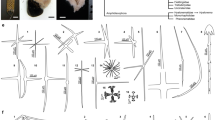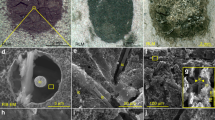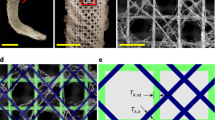Abstract
The minerals involved in the formation of metazoan skeletons principally comprise glassy silica, calcium phosphate or carbonate. Because of their ancient heritage, glass sponges (Hexactinellida) may shed light on fundamental questions such as molecular evolution, the unique chemistry and formation of the first skeletal silica-based structures, and the origin of multicellular animals. We have studied anchoring spicules from the metre-long stalk of the glass rope sponge (Hyalonema sieboldi; Porifera, Class Hexactinellida), which are remarkable for their size, durability, flexibility and optical properties. Using slow-alkali etching of biosilica, we isolated the organic fraction, which was revealed to be dominated by a hydroxylated fibrillar collagen that contains an unusual [Gly–3Hyp–4Hyp] motif. We speculate that this motif is predisposed for silica precipitation, and provides a novel template for biosilicification in nature.
This is a preview of subscription content, access via your institution
Access options
Subscribe to this journal
Receive 12 print issues and online access
$259.00 per year
only $21.58 per issue
Buy this article
- Purchase on Springer Link
- Instant access to full article PDF
Prices may be subject to local taxes which are calculated during checkout



Similar content being viewed by others
References
Shimizu, K., Cha, J., Stucky, G. D. & Morse, D. E. Silicatein alpha: cathepsin L-like protein in sponge biosilica. Proc. Natl Acad. Sci. USA 95, 6234–6238 (1998).
Cha, J. N. et al. Silicatein filaments and subunits from a marine sponge direct the polymerization of silica and silicones in vitro. Proc. Natl Acad. Sci. USA 96, 361–365 (1999).
Müller, W. E. G. et al. Silicateins, the major biosilica forming enzymes present in demosponges: protein analysis and phylogenetic relationship. Gene 395, 62–71 (2007).
Müller, W. E. G. et al. Unique transmission properties of the stalk spicules from the hexactinellid Hyalonema sieboldi. Biosens. Bioelectron. 21, 1149–1155 (2006).
Dayton, P. K. Observations of growth, dispersal and population dynamics of some sponges in McMurdo Sound, Antarctica, in Colloques internationaux du C.N.R.S. 291. Biologie des spongiaires (eds Levi, C. & Boury-Esnault, N.), 271–282 (Editions du Centre National de la Recherche Scientifique, 1979).
Ehrlich, H. & Worch, H. Collagen, a huge matrix in glass-sponge flexible spicules of the meter-long Hyalonema sieboldi, in Handbook of Biomineralization Vol. 1. The Biology of Biominerals Structure Formation (ed. Bäuerlein, E.) 23–41 (Wiley VCH, 2007).
Müller, W. E. G. et al. Silicatein expression in the hexactinellid Crateromorpha meyeri: the lead marker gene restricted to siliceous sponges. Cell Tissue Res. 333, 339–351 (2008).
Ehrlich, H. et al. A modern approach to demineralization of spicules in glass sponges (Porifera: Hexactinellida) for the purpose of extraction and examination of the protein matrix. Russ. J. Marine Biol. 32, 186–193 (2006).
Ehrlich, H. et al. Nanostructural organization of naturally occurring composites. Part I. Silica-collagen-based biocomposites. J. Nanomater. doi:10.1155/2008/623838 (2008).
Ehrlich, H., Heinemann, S., Hanke, T. & Worch, H. Hybrid materials from a silicate-treated collagen matrix, methods for the production thereof and the use thereof. International patent WO2008/023025 (2008).
Travis, D. F., Francois, C. J., Bonar, L. C. & Glimcher, M. J. Comparative studies of the organic matrices of invertebrate mineralized tissues. J. Ultrastruct. Res. 18, 519–550 (1967).
Ehrlich, H. et al. Nanostructural organization of naturally occurring composites. Part II. Silica-chitin-based biocomposites. J. Nanomater. doi:10.1155/2008/670235 (2008).
Leys, S. P. Cytoskeletal architecture and organelle transport in giant syncytia formed by fusion of hexactinellid sponge tissues. Biol. Bull. 188, 241–254 (1995).
Diehl-Seifert, B. et al. Attachment of sponge cells to collagen substrata: effect of a collagen assembly factor. J. Cell Sci. 79, 271–285 (1985).
Nakajima, T. & Volcani, B. E. 3,4-Dihydroxyproline: a new amino acid in diatom cell walls. Science 164, 1400–1401 (1969).
Hecky, R. E., Mopper, K., Kilham, P. & Degens, E. T. The amino acid and sugar composition of diatom cell walls. Mar. Biol. 19, 323–331 (1973).
Sadava, D. & Volcani, B. E. Studies on the biochemistry and fine structure of silica shell formation in diatoms. Formation of hydroxyproline and dihydroxyproliner in Nitzschia angularis. Planta 135, 7–11 (1977).
Schumacher, M. A., Mizuno, K. & Bachinger, H. P. The crystal structure of a collagen-like polypeptide with 3(S)-hydroxyproline residues in the Xaa position forms a standard 7/2 collagen triple helix. J. Biol. Chem. 281, 27566–27574 (2006).
Tilburey, G. E., Patwardhan, S. V., Huang, J., Kaplan, D. L. & Perry, C. C. Are hydroxyl-containing biomolecules important in biosilicification? A model study. J. Phys. Chem. B 111, 4630–4638 (2007).
Kulchin, Y. N. et al. Optical fibres based on natural biological minerals—sea sponge spicules. Quantum Electron. 38, 51–55 (2008).
Pouget, E. et al. Hierarchical architectures by synergy between dynamical template self-assembly and biomineralization. Nature Mater. 6, 434–439 (2007).
Exposito, J.-Y., Cluzel, C., Garrone, R. & Lethias, C. Evolution of collagens. Anat. Rec. 268, 302–316 (2002).
Livingston, B. T. et al. A genome-wide analysis of biomineralization-related proteins in the sea urchin Strongylocentrotus purparatus. Dev. Biol. 300, 335–348 (2006).
Acknowledgements
This work was partially supported by NE/C511148/1 grant to M.J.C. and J.T.-O., by a joint grant from Deutscher Akademischer Austauschdienst (DAAD) (grant ref. 325; A/08/72558) and Russian Ministry of Education and Science (RMES) (AVCP grant no. 8066) to V.V.B., and by the Erasmus Mundus External Co-operation Programme of the European Union 2009 to D.K. The Centre of Excellence in Mass Spectrometry (CoEMS) at York is supported by Science City York and Yorkshire Forward using funds from the Northern Way Initiative. The authors also thank H. Lichte for use of the facilities at the Special Electron Microscopy Laboratory for high-resolution and holography at Triebenberg, TU Dresden, Germany. The authors thank G. Bavestrello, K. Tabachnick, M. Hofreiter, H. Roempler and E. Bäeuerlein for their helpful discussions. Finally, the authors are very grateful to S. Paasch, H. Meissner, G. Richter, T. Hanke, O. Trommer, A. Mensch, S. Heinemann for excellent technical assistance. G.W. acknowledges funding from the German Science Foundation (DFG). Financial support by DFG (Graduiertenkolleg 378) to R.H. and T.L. and the European Fund for Regional Structure Development (EFRE, European Union and Free State Saxonia) to R.H. is gratefully acknowledged.
Author information
Authors and Affiliations
Contributions
All authors contributed to the design or execution of experiments, or analysed data. H.E. supervised the experiments, carried out demineralization experiments, performed collagen isolation, and wrote the manuscript. P.S. performed SEM and HRTEM, and prepared figures. A.E. collected, prepared and identified sponge samples and contributed to writing the manuscript. M.M., D.V.V., K.K. and S.L.M. performed NEXAFS experiments and designed figures. M.T. and V.V.B. carried out collagen modification. S.H. performed FTIR and prepared figures. E.B. performed NMR. R.D. performed Edman degradation and R.H. and T.L. performed amino acid analysis and mass spectrometry. M.C., H.K., C.S., Y.Y., E.C., D.A., M.L., C.B. and J.T.-O. were involved in acquiring and interpreting the mass spectrometric data, and M.C., H.K., E.C., D.A. and J.T.-O contributed to the writing of the manuscript. H.W., M.C., H.E., G.W., J.R., V.S. and E.B. analysed the results with regard to evolutionary implications and mechanisms of biomineralization, designed concepts, and wrote the manuscript.
Corresponding authors
Ethics declarations
Competing interests
The authors declare no competing financial interests.
Supplementary information
Supplementary information
Supplementary information (PDF 2539 kb)
Rights and permissions
About this article
Cite this article
Ehrlich, H., Deutzmann, R., Brunner, E. et al. Mineralization of the metre-long biosilica structures of glass sponges is templated on hydroxylated collagen. Nature Chem 2, 1084–1088 (2010). https://doi.org/10.1038/nchem.899
Received:
Accepted:
Published:
Issue Date:
DOI: https://doi.org/10.1038/nchem.899
This article is cited by
-
Insights into the structure and morphogenesis of the giant basal spicule of the glass sponge Monorhaphis chuni
Frontiers in Zoology (2021)
-
Fabrication of silica on chitin in ambient conditions using silicatein fused with a chitin-binding domain
Bioprocess and Biosystems Engineering (2021)
-
Lamellar architectures in stiff biomaterials may not always be templates for enhancing toughness in composites
Nature Communications (2020)
-
1H NMR spectroscopy study of structural water in rehydrated biocomposite of Spongilla lacustris freshwater demosponge origin
Applied Physics A (2020)
-
Modern scaffolding strategies based on naturally pre-fabricated 3D biomaterials of poriferan origin
Applied Physics A (2020)



